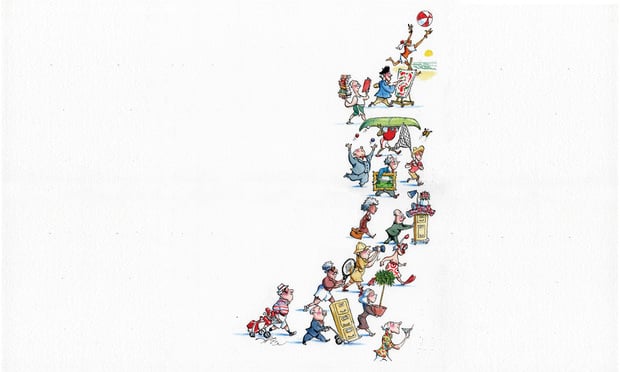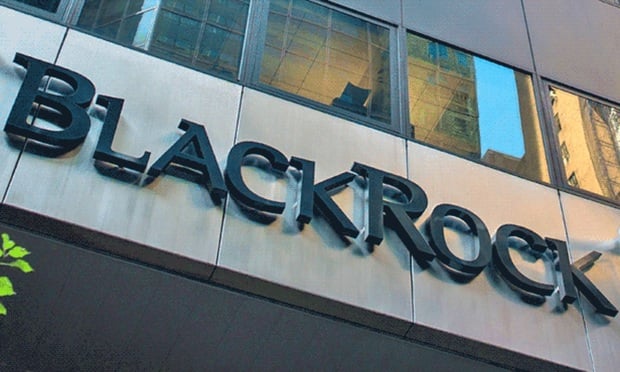 Illustration by Michael Witte
Illustration by Michael Witte
Four million Americans will be turning 65 every year for the next four years in what many are dubbing the "Retirement Wave." While these 16 or so million people might be reaching retirement age, how is the health of their retirement plans?
Many will have to remain in the workforce longer for them to be able to enjoy their retirement comfortably. Employees may want to retire at 65, but they need to keep working, according to a new Equitable survey of 1,000 consumers. In fact, nearly half (47%) say it is unrealistic that they will retire at age 65 and most likely that they will retire nearly a decade later at age 74 – a more attainable goal to reach retirement.
Recommended For You
What should those standing on the threshold of retirement do in order to ensure the safety of their retirement savings? Should they be making their investments more conservative and risk averse? Should those who find themselves behind the eight ball be making riskier investments to make up for lost ground?
We talked to Joseph Patrick Roop, president of Belmont Capital Advisors who discusses 401(k) plans and the current state of the average American retirement plan and what can be done to protect and enhance employee savings.
Q: While 4 million Americans will be turning 65 every year for the next four years, how is the health of their retirement plans?
A: I would ask whether the participants have "a plan," and I quote, "a plan." The number one thing to do as employees enter the years approaching retirement is for them to have a written plan. Many 401(k) offerings have many different solutions, and it's not to say that they're good or bad, but do they have a financial advisor and a plan coordinating together to ensure they know they are on track? Do they know where they are today and how much it will take to get them there for their targeted retirement date? For example, if an airline pilot is forced to retire at age 65, he could also pick up a part-time job making $20,000 a year, which would be really helpful and could extend his retirement monies to ensure he leaves his children money. So, number one – Do employees have a plan?
Q: Will many employees have to remain in the workforce longer for them to be able to enjoy their retirement comfortably?
A: Allow me to share an example: $1 million invested using the 4% withdrawal rule equals $40,000 a year. If an employee had a part-time job, even if for a little while, like 2 to 5 years, this could improve the retiree's health, and it could be doing something they love and enjoy. They are probably used to making $50,000 to $60,000 or maybe even $100,000 or $200,000 a year, but if they picked up a part-time job where they made $20,000 a year, that's like a half million dollars working for them, and this can really do a lot to prolong their life savings. It can also help out their overall health and vitality, and it is going to keep their brain sharp, not counting their physical exercise. It's important to know that without our health, we have no wealth! What I would advise here is for employees to do something they love! For the smaller wages, they can work for the YMCA. It could be hobby-type things, but again, they're going to make $10,000 or $20,000 a year – $10,000 is like $250,000 working for you, $20,000 is like $500,000 working for you. While the question is staying in the workforce longer, what if they chose what workforce they work for? Maybe someone stops being a banker and becomes a barista, or they work at a retirement community, or a golf community, something like that that pays them a modest income, but now they're doing something they love, and it's much more enjoyable.
Q: What should those standing on the threshold of retirement do in order to ensure the safety of their retirement savings?
A: If you are over 59 ½, you are getting close to that threshold. There is a rule that typically when you are over 59 ½, you can do an in-service distribution from your retirement plan. If you are going to do an in-service distribution, that will allow participants to invest in other things that the 401(k) does not offer. It can enable them to work one-on-one with a financial advisor, someone who can create and develop a plan for them. It is important that employers communicate their in-service distribution option to their staff and employees so that they know about it and that their employees have the ability and plan structure structured in that they are allowed to do the in-service distribution.
Technically, this could be done before age 59 ½, but again, 59 ½ is when it is standard for most plans. As a general rule for the employees out there, if you're over 59 ½, we would say look at that option and look at what other things can be available to you because 401(k)s were designed to be a mass investment: 401(k)s were designed to be for the masses and easy for EVERYONE. Think about it like bowling with guardrails: 401(k)s were designed to give you a few choices so you don't go off the rails.
Since each family and person is very, very different, you want to encourage your employees to work with the financial advisor one-on-one, and when they reach that 59 ½, do the in-service distribution and have their very own personalized plan.
Q: What can employers do to ensure employees are prepared to retire at 65?
A: Having a plan in place five years or 10 years ahead of schedule and helping educate employees on something called Sequence Risk and making sure people, again, have a specialized written plan that they are aware of in helping them make sure they know how to do the in-service distribution would be critical.
Q: Should those employees close to retirement be making their investments more conservative and risk averse?
A: Yes! As people get closer or enter into retirement, this dovetails into what I called that sequence risk problem. As you enter into retirement, even a short market fall could adversely impact your income for the rest of your life, so we want to make sure people are prepared for the sequence risk. We want to make sure that, again, this falls back to the in-service distribution, allowing clients to reallocate to potentially something that has principal preservation.
In the most recent years the government has tried to get annuities added to the 401(k). There haven't been very many added. This is where clients can allocate to something that has principal preservation and could also give them income for life, so those would be much more conservative. Some of them can be guaranteed and would have a much lower risk in those types of programs that will help people with the sequence of risk problems. Whether you all say a sequence of risk or not, it is probably the number one reason people run out of money in retirement, and having principal preservation and other things that can give them a lifetime, guaranteed income would be critical. So absolutely, let's help people as they get older become more conservative and be risk-averse, and giving them lifetime income would be very beneficial.
Related: Retirement reset: Pre-retirees need help reevaluating lifetime income offerings
Q: How can employers help those who find themselves behind the eight ball?
A: The first thing that comes to mind here is this: What if employers give employees a day off as long as they show proof that they met with a financial advisor or that they met with a fiduciary-based planning advisor, and they can bring back a plan? Much like employees get reimbursed for out-of-pocket expenses that they might face on a business trip, give them a paid day off and let them meet with a financial planner who can put together a specific financial plan for their retirement. Again, make sure employer plans offer in-service distributions, and if you wanted to be a great employer, you could offer it before the age of 59 1/2 and give people more access to their funds earlier.
Working after you retire would definitely add a lot to the bottom line: $1 million at 4% equals $40,000 a year and just a modest income of $20,000 a year working part-time at a place you would like to be working, whether it's at a boat store, golf club or maybe it's the YMCA, something that you enjoy and will have fun at and get exercise! That is like having a half million dollars working extra for you as you start off your retirement, and it could really prolong your investments.
© Touchpoint Markets, All Rights Reserved. Request academic re-use from www.copyright.com. All other uses, submit a request to [email protected]. For more inforrmation visit Asset & Logo Licensing.







